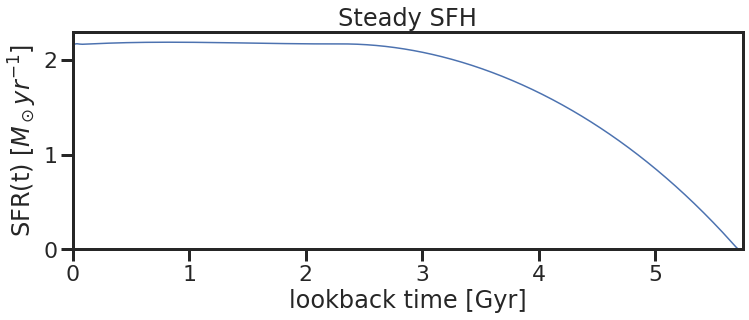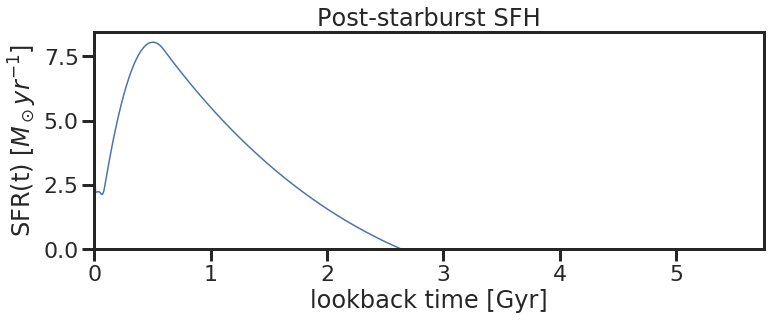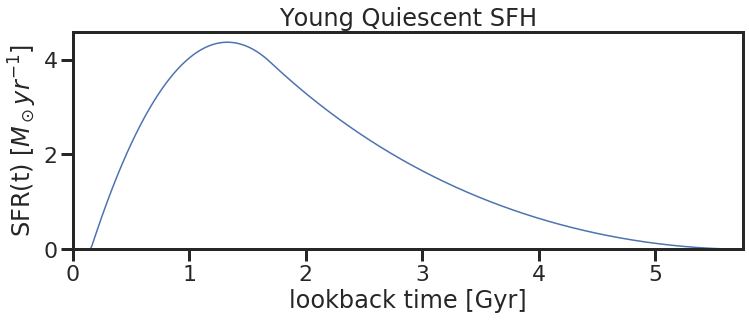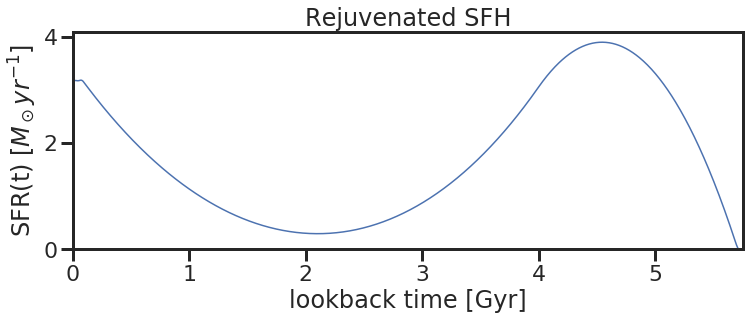The GP-SFH module¶
Creating different shapes using SFH-tuples¶
The dense_basis code contains a module for creating smooth star formation history from a tuple consisting of (M:math:_*, SFR, {\(t_X\)}) - the stellar mass, star formation rate, and a set of lookback times at which the galaxy forms N equally spaced quantiles of its stellar mass.
This parametrization comes with a lot of flexibility, and allows us to create a large range of SFH shapes even with a small number of parameters. Here we show a few examples, showing how we create a variety of different SFH shapes with just 2 free parameters - the SFR and the t\(_{50}\).
[1]:
import dense_basis as db
import numpy as np
import matplotlib.pyplot as plt
Starting dense_basis. please wait ~ a minute for the FSPS backend to initialize.
[2]:
Nparam = 1
redshift = 1.0
logMstar = 10.0
Let’s start with an SFH that is rising throughout a galaxy’s lifetime, such as may be expected for high-redshift star forming galaxies. Since we are considering a galaxy with \(M_* = 10^{10}M_\odot\) at z=1, we choose a reasonably high SFR of 10 \(M_\odot/yr\). Since the SFR is rising, we also choose a short \(t_{50}\), since it is rapidly building forming its stars. Running this through the model, we get:
[3]:
logSFR = 1.0
t50 = 0.6 # t50, lookback time, in Gyr
sfh_tuple = np.hstack([logMstar, logSFR, Nparam, db.scale_t50(t50,redshift)])
sfh, timeax = db.tuple_to_sfh(sfh_tuple, redshift)
fig = db.plot_sfh(timeax, sfh, lookback=True)
plt.title('Rising SFH')
plt.show()

We next consider the case of reasonably steady star formation. This is different from constant star formation, because SFR goes to 0 smoothly as we approach the big bang. In this case, we choose an SFR closer to the expected lifetime average for a massive galaxy at z=1, and a \(t_{50}\) close to half the age of the universe at the redshift of observation. Doing this gives us:
[4]:
logSFR = 0.335
t50 = 2.3 # t50, lookback time, in Gyr
sfh_tuple = np.hstack([logMstar, logSFR, Nparam, db.scale_t50(t50,redshift)])
sfh, timeax = db.tuple_to_sfh(sfh_tuple, redshift)
fig = db.plot_sfh(timeax, sfh, lookback=True)
plt.title('Steady SFH')
plt.show()

We now look at the class of quenched and quenching galaxies.
For the post-starburst SFH, we create a similar setup to the rising SFH, but with a low SFR at the time of observation. Since the galaxy still formed a lot of stars in the recent past but is not doing so now, this creates the distinctive post-starburst shape.
[5]:
logSFR = 0.5
t50 = 0.6 # t50, lookback time, in Gyr
sfh_tuple = np.hstack([logMstar, logSFR, Nparam, db.scale_t50(t50,redshift)])
sfh, timeax = db.tuple_to_sfh(sfh_tuple, redshift)
fig = db.plot_sfh(timeax, sfh, lookback=True)
plt.title('Post-starburst SFH')
plt.show()

We also consider two simple types of quenched galaxies, obtained easily by setting the recent SFR to a very low value. To consider the different possible shapes for a quenched SFH, we use a recent and an older value for the \(t_{50}\), to obtain SFHs that quenched either gradually or aburptly.
[6]:
logSFR = -3.0
t50 = 4.6 # t50, lookback time, in Gyr
sfh_tuple = np.hstack([logMstar, logSFR, Nparam, db.scale_t50(t50,redshift)])
sfh, timeax = db.tuple_to_sfh(sfh_tuple, redshift)
fig = db.plot_sfh(timeax, sfh, lookback=True)
plt.title('Old Quiescent SFH')
plt.show()

[7]:
logSFR = -3.0
t50 = 1.7 # t50, lookback time, in Gyr
sfh_tuple = np.hstack([logMstar, logSFR, Nparam, db.scale_t50(t50,redshift)])
sfh, timeax = db.tuple_to_sfh(sfh_tuple, redshift)
fig = db.plot_sfh(timeax, sfh, lookback=True)
plt.title('Young Quiescent SFH')
plt.show()

Finally, we also consider the case of a rejuvenated SFH, which had a significant lull between two periods of active star formation. To create an example of this kind of SFH, we use a reasonably large \(t_{50}\), which tells the GP-SFH module that the galaxy formed 50% of its stars early on. Coupled with an SFR that indicates active star formation at the time of observation, this means that there had to be a period between these two when the galaxy did not form a lot of mass, leading to
this distinctive shape.
[8]:
logSFR = 0.5
t50 = 4.0 # t50, lookback time, in Gyr
sfh_tuple = np.hstack([logMstar, logSFR, Nparam, db.scale_t50(t50,redshift)])
sfh, timeax = db.tuple_to_sfh(sfh_tuple, redshift)
fig = db.plot_sfh(timeax, sfh, lookback=True)
plt.title('Rejuvenated SFH')
plt.show()
